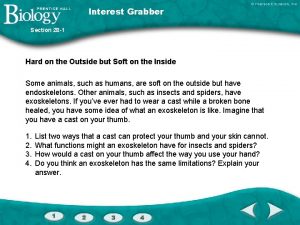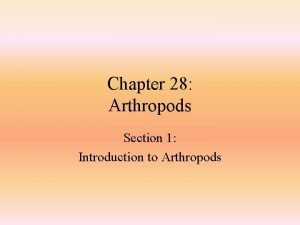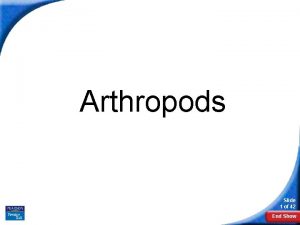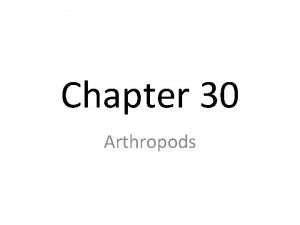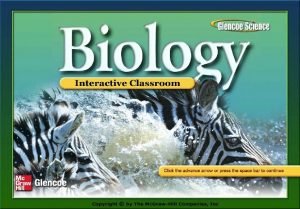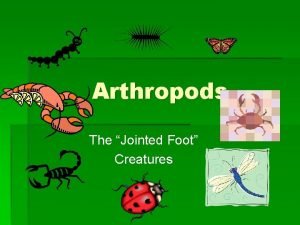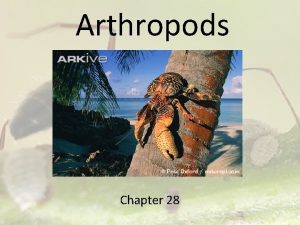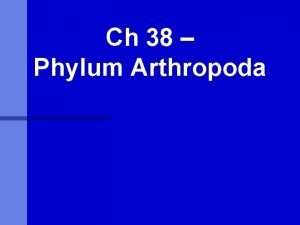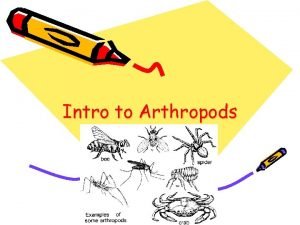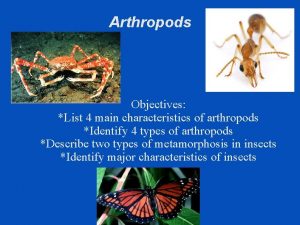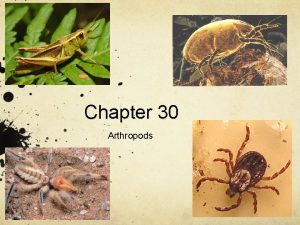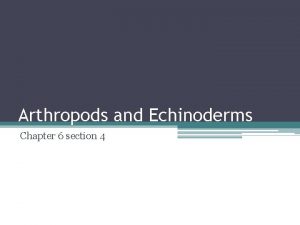CHAPTER 10 SECTION 2 Arthropods Characteristics of Arthropods









- Slides: 9

CHAPTER 10 SECTION 2 Arthropods

Characteristics of Arthropods • Four major groups • Crustaceans • Arachnids • Centipedes and Millipedes • Insects • Shared characteristics • Invertebrates • External skeleton • Segmented body • Jointed attachments called appendages (wings, mouthparts, legs)

Outer Skeleton • Exoskeleton • Waxy covering, or outer skeleton • Protects and helps prevent evaporation of water (adaptation) • When an arthropod grows… • Molting occurs • Molting: process of shedding an outgrown exoskeleton • New exoskeleton is soft for a little while, less protection

Segmented Body • Bodies made up of many identical-looking segments • Easily seen on millipedes and centipedes • Normally three sections • Head, midsection, and a hind section

Jointed Appendages • Your fingers! • Give the animal flexibility and enable it to move • Use legs to move, catch prey, defending against predators • Use antenna, has sense organs for smelling, tasting, and touching

Crustaceans • Shrimp, crabs, crayfish, lobsters • Thrive in freshwater lakes and rivers • Two or three body sections • Five or more pairs of legs • Two pairs of antennae • Get oxygen from gills • Life Cycle • Crustaceans begin their lives as microscopic, swimming larva and develop into adults by metamorphosis (a process by which an animal’s body undergoes dramatic changes in form during life cycle)

Arachnids • Spiders, Mites, Scorpions, Ticks • Two body sections (first body section=head and midsection, hind section=abdomen) • Four pairs of legs • No antennae

Arachnids SPIDERS MITES • All spiders • Another are name is a predators, chigger eat insects • Parasites • Hollow fangs, inject venom into prey • Rarely bite people SCORPIONS • Live in hot climates • Active at night • Stinger at end of abdomen TICKS • Parasites • Live on the outside of a hosts body

Centipedes and Millipedes • Have two body sections and many pairs of legs • Centipedes • One pairs of legs attached to each segment • Sometimes more than 100 segments • Predators that inject venom into prey • Millipede • Two pairs of legs attached to each segment • Sometimes more than 80 segments • Scavengers
 Section 28-1 introduction to the arthropods answers
Section 28-1 introduction to the arthropods answers Chapter 28: arthropods worksheet answers
Chapter 28: arthropods worksheet answers Section 28-1 introduction to the arthropods
Section 28-1 introduction to the arthropods Characteristics of arthropods
Characteristics of arthropods Chapter 26 section 3 insects and their relatives
Chapter 26 section 3 insects and their relatives Arthropods characteristics
Arthropods characteristics Arthropods characteristics
Arthropods characteristics Arthropods characteristics
Arthropods characteristics Arthropods characteristics
Arthropods characteristics Arthropods characteristics
Arthropods characteristics
